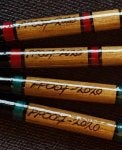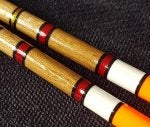Floats always catch the angler's eye and the wonderful examples on this thread are no exception. Both modern and traditional varieties are displayed. This is an attempt to look beyond the image of floats, with a view to discover what prompts their designs. For example, when using basic quills to make wagglers, then length is proportional to shotting capacity, plus extra length will help sink the line and minimise the wind effect. That is a pretty obvious statement, until you add a cork/balsa body. What determines the dimensions then, bearing in mind the wind/length thing? Similarly the with river floats. Shallow water calls for short floats and fishing shallow water at distance dictates short chunky floats, again straight forward. Deep water equals bigger floats carrying more lead. Here again Avon floats with cork /balsa bodies. So when making floats what rule of thumb or yardstick do you use or do you just follow traditional proportions. When I make stick floats I use a ratio of 1:2 in respect of body to stem, but it's not based on any float design physics. Thoughts anyone? Pete.







